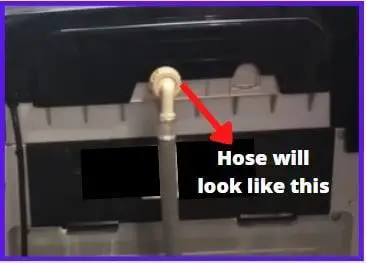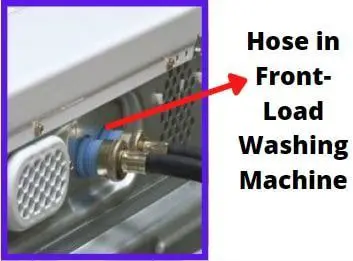Have you ever had a washing machine hose that was just a little too tight? Or, maybe one time you snapped the connector while trying to attach it to the washing machine.
If either of these has happened to you, then this blog post is for you!
In this post, you will learn how to loosen a washing machine hose safely without having to use any professional tools.
Let’s jump right into it.
Table of Contents
What you will need?
In order to loosen the washing machine hose, you will need a few supplies which are listed below.
- A Bucket
- A Towel
- Adjustable Wrench or Pliers(Optional and only needed in a few cases)
Once you have the above Items handy, the next step is to locate them.
Steps to loosen washing machine hose
Step 1: Turn Off the Washer
This is an important step that should not be ignored.
Before you move or perform maintenance OR installation-related tasks, it’s recommended to turn off the washer as a precautionary measure.
To do this, locate the power button on your washing machine and press it to turn it off.
Once the power is off, unplug the washer from the wall outlet.
Step 2: Locate the Hose
The first step is to locate the hose that you need to loosen.
If you have a front-loading washing machine, the hose is usually located on the back of the machine.
For a top-loading washing machine, the hose is generally located on the side or back of the machine.
If you are unsure of where the hose is located, check your washing machine’s manual OR contact the manufacturer.
In most cases, the hose in a top load washer will be located behind and will look similar to the image below.

Similarly, the hose in a front-load washing machine will look something like this.

Step 3: Place a bucket behind the Washer
Once you have located the hose, the next step is to place the bucket behind your washer, just underneath the hose area.
This will help to catch any water that may drip from the hose while you are working on it.
Also, ensure that a thick cloth or a towel is placed under the bucket so that it doesn’t slide or move around and protects the floor from getting wet
Step 4: Loosen the hose clamp
Now that you have located the hose and placed the bucket under the hose area at the backside of your washer.
The next step is to loosen the hose clamp.
To do this, simply turn the screws anticlockwise until the clamps are loose.
Next, point the end to the bucket and let any water drain out completely.
Note: If the clamp is tight you may gently use a wrench or pliers to loosen it.
Step 5: Check if it is clogged
After you have pointed the hose to the bucket, the next step is to check and see if the hose is clogged with lint or debris.
If the hose is clogged, it will need to be cleaned out before reattaching it.
To clean the hose, simply use a paper towel or cloth to remove any lint or debris that may be blocking the water from flowing through.
You may even use a vinegar solution to clean and unblock the hose.
Once the hose is clear, reattach it to the washing machine and tighten the clamp securely.
Step 6: Reattach the hose
After you have cleaned the hose, simply reattach it back to its original slot.
To do this, simply slide the hose clamp back over the hose and screw it tightly into place.
Step 7: Test if it works
The last step is to test and see if it works.
To do this, simply turn on the washing machine and let it run for a few minutes, and see if the hose is leaking.
If there are no leaks, then you have successfully loosened and tightened the washing machine hose.
If it leaks, you may need to check the location from where it leaks and try to detach and reattach the hose again.
Addressing Common Issues and Troubleshooting Tips for Loosening Washing Machine Hoses
While attempting to loosen a washing machine hose, you may encounter common issues that can make the process challenging.
Addressing these issues promptly and applying appropriate troubleshooting tips can ensure a successful and safe experience.
Here are some of the common problems you may face and corresponding solutions:
Rusted or Stuck Hose Clamps
Problem: Hose clamps that have rusted or are tightly stuck can be difficult to loosen.
Troubleshooting Tips:
- Apply a lubricant such as WD-40, engine oil, or penetrating oil around the clamp to loosen the rust.
- Let it sit for a few minutes before attempting to turn the screws.
- Use a pair of pliers or adjustable wrench for extra leverage to break the resistance and loosen the clamp gradually.
- If the clamp is severely corroded and cannot be loosened, consider replacing it with a new one.
Clogged Hose
Problem: Accumulated lint, debris, or mineral deposits can clog the hose, restricting water flow.
Troubleshooting Tips:
- Disconnect the hose from the washing machine and the water supply.
- Gently clean the inside of the hose with a paper towel or cloth to remove any obstructions.
- If the clog is persistent, try using a vinegar solution to dissolve mineral deposits.
- After cleaning, reattach the hose securely to prevent leaks.
Leaky Hose Connections
Problem: After reattaching the hose, it might still leak water, causing inconvenience.
Troubleshooting Tips:
- Ensure the hose is properly aligned with the connector on the washing machine and the water supply valve.
- Double-check the tightness of the hose clamp; if it’s loose, tighten it further to form a watertight seal.
- Inspect the hose for any visible cracks, tears, or signs of wear. Replace the hose if necessary.
Incorrect Reattachment
Problem: Users might face difficulties in reattaching the hose correctly after cleaning or inspection.
Troubleshooting Tips:
- Consult the washing machine’s user manual for specific instructions on reattaching the hose properly.
- Ensure the hose fits snugly into its slot and that the hose clamp secures it tightly.
- Avoid over-tightening the hose clamp, as it can cause damage or leaks.
Unexpected Water Leakage
Problem: Users may notice water leaking from other parts of the washing machine during or after the process.
Troubleshooting Tips:
- Examine nearby hoses and connections for any signs of leaks or damage.
- Verify that all hoses and connectors are secure and properly fitted.
- If leakage persists, consider seeking professional assistance to diagnose and fix the issue.
Remember, safety is paramount when working with washing machine hoses.
Always turn off the power and unplug the machine before attempting any maintenance.
If you are unsure or encounter complex issues, it’s best to seek help from a qualified technician to avoid further damage to the washing machine.
Washing machine hose stuck on spigot
If your washing machine hose is stuck on the spigot and you’re having trouble removing it, here are some troubleshooting steps you can follow to safely resolve the issue:
Step 1: Turn Off the Water Supply
First, ensure that the water supply to the washing machine is turned off.
This is usually done by shutting off the water valves connected to the hoses.
Turning off the water supply will prevent any water from flowing when you remove the hose.
Step 2: Wear Protective Gloves
Put on a pair of rubber gloves to provide better grip and protect your hands from any sharp edges or debris.
Step 3: Use Pliers
You can use a pair of slip-joint pliers or channel-lock pliers to help you grip the hose securely.
Place the pliers near the connection point where the hose is stuck.
Step 4: Apply Penetrating Oil
If the hose is still stuck, you can apply a penetrating oil or lubricant like WD-40 to the threads of the spigot.
Let it sit for a few minutes to help loosen any corrosion or debris that may be causing the hose to stick.
Step 5: Gently Twist and Turn
While holding the pliers securely on the hose, gently twist and turn the hose counterclockwise to loosen it from the spigot. Avoid using excessive force as it may damage the hose or the spigot.
Step 6: Heat the Connection (if necessary)
If the hose remains stuck, you can try using heat to expand the metal and break any rust or corrosion.
A hairdryer or a heat gun can be used for this purpose.
Be cautious not to overheat and damage the components, and always prioritize safety when using heat sources.
Step 7: Tap with a Rubber Mallet
Lightly tap the hose connection point with a rubber mallet to help dislodge it. This can help break any corrosion that’s holding it in place.
Also, perform the below checks, if the above steps does not help.
- Check for Obstructions: Inspect the hose and the spigot for any obstructions, debris, or foreign objects that might be preventing the hose from turning.
- Seek Professional Help: If you’ve tried the above steps and the hose is still stuck, or if you’re uncomfortable attempting further removal, it’s best to contact a professional plumber or technician. They have the necessary tools and expertise to resolve the issue without causing damage.
Tips to keep washing machine hoses in good condition
Now that you know how to loosen a washing machine hose, here are some tips to keep your hoses in good condition.
- Inspect your hoses regularly for any signs of wear or tear.
- If you see any cracks or holes in the hose, replace it immediately.
- Do not leave your hoses kinked or bent, as this can cause them to leak.
- Make sure to regularly clean out your hoses to prevent any lint or debris from building up.
- You can use a vinegar solution to clean your hoses, as this will also help to kill any bacteria that may be present.
Final Thoughts
Loosening a washing machine hose is extremely easy and can be done by anyone.
In most cases, the user manual should have the instructions to clean the hoses.
If your manual doesn’t have any instructions to clean the hose, simply follow the above instructions.
Additionally, be sure to follow the caring tips above to keep the hoses in good condition.
Frequently Asked Questions
Here are some frequently asked questions related to washing machine hoses.
Why does my washing machine hose need to be loosened?
Over time, the washing machine hose can become tight due to the water pressure and buildup around joints. This can cause the hose to leak, choke, and wear out. Loosening and cleaning followed by re-tightening them back will help to prevent leakage and slow down the wear and tear.
How to loosen a tight washing machine hose?
If your washing machine hoses are extremely tight due to rusting issues, you may make use of grease OR engine oil to loosen them. Just apply a small amount of either one around the hose and let it sit for about 5 minutes before using a wrench or pliers to loosen the washing machine hose.
How can I keep my washing machine hoses from rusting?
Rusting is commonly caused by repeated exposure to water and age. If you see any rust on your washing machine hoses, use a WD40 solution or any antirust solution, followed by cleaning them using a damp cloth. You should also try to keep your washing machine hoses as dry as possible when not in use.
You May Also Like
- How to Troubleshoot a portable washing machine?
- How to Clean a portable washing machine?
- How to use a portable washing machine effectively?
- Washing Machine Detergents: 15 Things you must know about it
- How to keep the washing machine in a small bathroom?
- How to Open OR Turn On the valve in a washing machine?
- Bosch Washing Machine not draining? Try this





